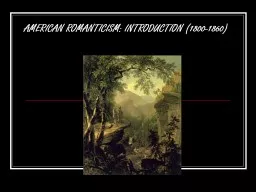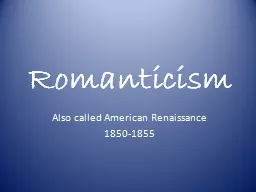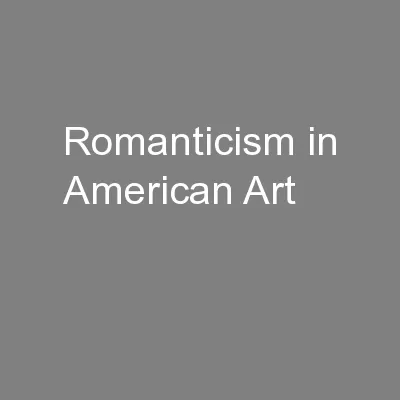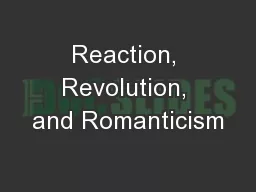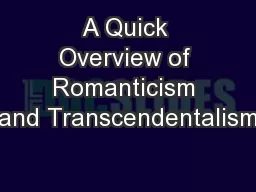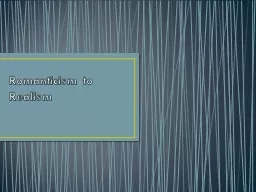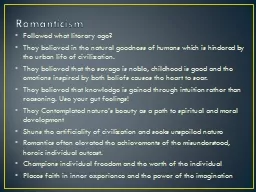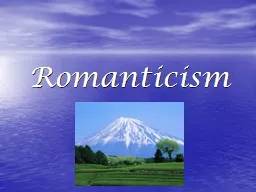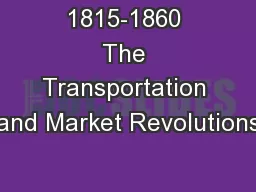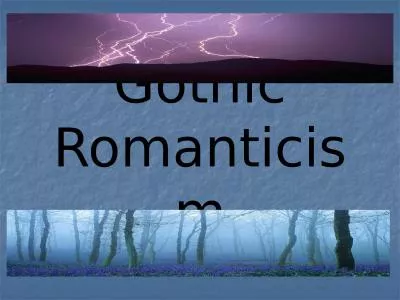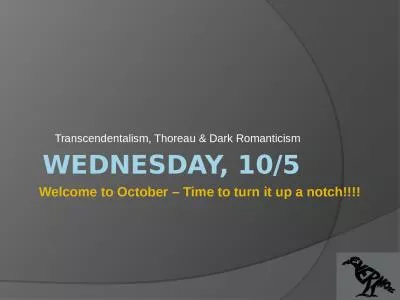PPT-AMERICAN ROMANTICISM: INTRODUCTION (1800-1860)
Author : phoebe-click | Published Date : 2018-10-22
The Age of Reason or The Enlightenment Founded on Deism Logic Inalienable rights It also brought Industrialization growth of cities and factories American expansion
Presentation Embed Code
Download Presentation
Download Presentation The PPT/PDF document "AMERICAN ROMANTICISM: INTRODUCTION (1800..." is the property of its rightful owner. Permission is granted to download and print the materials on this website for personal, non-commercial use only, and to display it on your personal computer provided you do not modify the materials and that you retain all copyright notices contained in the materials. By downloading content from our website, you accept the terms of this agreement.
AMERICAN ROMANTICISM: INTRODUCTION (1800-1860): Transcript
The Age of Reason or The Enlightenment Founded on Deism Logic Inalienable rights It also brought Industrialization growth of cities and factories American expansion Lewis and Clark and Manifest Destiny . By: Kelsey Sauers, Braden Hays, Joseph Abera, and Josh Patino. What is Romanticism? . Romanticism:. a movement in the arts and literature that emphasizes inspiration and primacy of the individual . Romanticism has very little to do with things popularly thought of as “romantic.” (although love may occasionally be the subject of Romantic art). Early 1800s -1865 . What Romanticism is NOT!. Despite the name “Romantic”, this literary period DOES NOT deal with sappy love stories. . So…What is Romanticism?. Romanticism is the name of the literary period that followed the Age of Reason (Revolutionary literature) . Also called American Renaissance. 1850-1855. What is Romanticism?. A movement that considers the rational inferior to the intuitive.. What are Romanticism’s roots?. Romanticism roots. Reaction against Age of . and Literature. 1800-1855. What led to Romanticism?. Independence in religion and politics. Expansion in America. U. rbanization and industrialism (dehumanization). Confusion generated by science (Darwin, for example). Is there a justifiable reason to kill another person? Why or why not?. Heroic despair: . hero strays from traditional ideals. Women. don’t fulfill traditional roles. Villain: . often misunderstood and lonely. 3.2 – AP European History. University High School. I. The Conservative European Order. The Dual Revolution. FR = Politics, IR = Economic/Social. Growth of industrial middle class. Revitalized conservatism. Poe, Irvin, Hawthorn, Emerson, . Thoreau. , Whitman, etc... Romanticism. A literary movement originally “invented” by European writers that was then adopted and popularized by American writers in the early 1800s. Good Morning! 1/23/2017. Turn-in:. . Stamp Sheet. Take out: . Romanticism homework, journal, writing utensil. Fast Five:. What are the elements of Romanticism?. Homework. :. . Select one more Romantic poem – analyze for elements as we have done in class (at least 4 elements + analysis in a similar chart). . Followed what literary age?. They . believed in the natural goodness of humans which is hindered by the urban life of civilization. . They believed that the savage is noble, childhood is good and the emotions inspired by both beliefs causes the heart to soar.. Contrasted with Rationalism which is commonly associated with reason and restriction.. Originated In the mid 1800’s in Germany due to a strong influence of literature, music and art. Characteristics. 1. Canals, steamboats, and railroads revolutionized American economic and social life during the antebellum period between 1820 and 1860.. 2. Key transportation developments. Turnpikes such as the National Road promoted trade and communication with the Old Northwest.. English romanticism developed as a reaction to many social influences: . --the unrest of the French Revolution . --the excesses of the Industrial Revolution. --the widespread poverty and oppression of workers.. Definition:. Dark romanticism which focuses on perceived darkness in the human soul and the embrace of sin and evil in the society.. Origin. Began during social upheaval in England. Idealistic views of economic and political conditions contradicted realistic state of economy and politics. Welcome to October – Time to turn it up a notch!!!!. Thoreau Re-Cap. How did the two biographical pieces differ? . Did you talk about this yesterday? Why not?. How did the excerpts from . Walden.
Download Document
Here is the link to download the presentation.
"AMERICAN ROMANTICISM: INTRODUCTION (1800-1860)"The content belongs to its owner. You may download and print it for personal use, without modification, and keep all copyright notices. By downloading, you agree to these terms.
Related Documents

